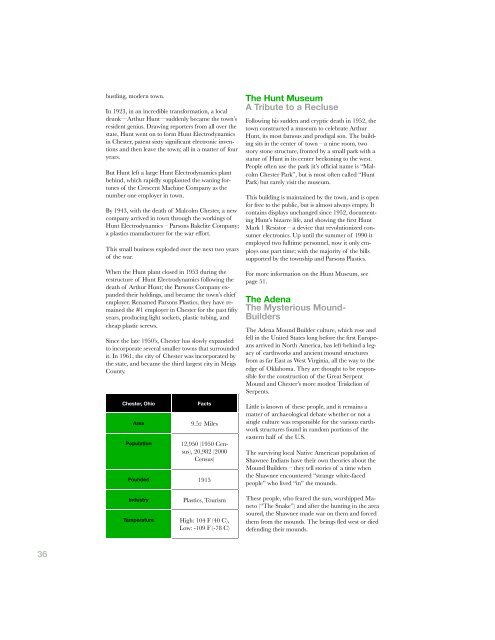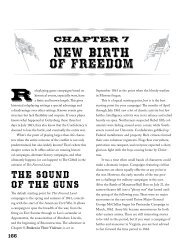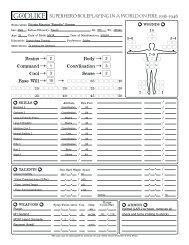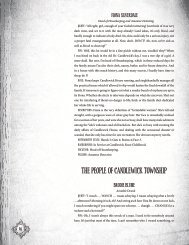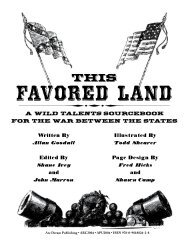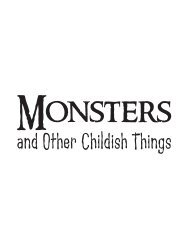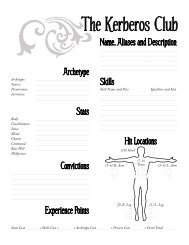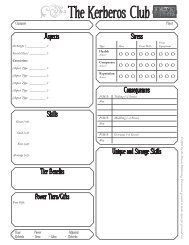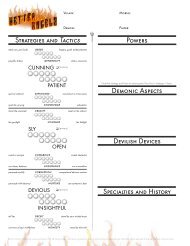Future/Perfect 1-3 - Arc Dream Publishing
Future/Perfect 1-3 - Arc Dream Publishing
Future/Perfect 1-3 - Arc Dream Publishing
Create successful ePaper yourself
Turn your PDF publications into a flip-book with our unique Google optimized e-Paper software.
36<br />
bustling, modern town.<br />
In 1923, in an incredible transformation, a local<br />
drunk—Arthur Hunt—suddenly became the town’s<br />
resident genius. Drawing reporters from all over the<br />
state, Hunt went on to form Hunt Electrodynamics<br />
in Chester, patent sixty significant electronic inventions<br />
and then leave the town; all in a matter of four<br />
years.<br />
But Hunt left a large Hunt Electrodynamics plant<br />
behind, which rapidly supplanted the waning fortunes<br />
of the Crescent Machine Company as the<br />
number one employer in town.<br />
By 1943, with the death of Malcolm Chester, a new<br />
company arrived in town through the workings of<br />
Hunt Electrodynamics – Parsons Bakelite Company;<br />
a plastics manufacturer for the war effort.<br />
This small business exploded over the next two years<br />
of the war.<br />
When the Hunt plant closed in 1953 during the<br />
restructure of Hunt Electrodynamics following the<br />
death of Arthur Hunt; the Parsons Company expanded<br />
their holdings, and became the town’s chief<br />
employer. Renamed Parsons Plastics, they have remained<br />
the #1 employer in Chester for the past fifty<br />
years, producing light sockets, plastic tubing, and<br />
cheap plastic screws.<br />
Since the late 1950’s, Chester has slowly expanded<br />
to incorporate several smaller towns that surrounded<br />
it. In 1961, the city of Chester was incorporated by<br />
the state, and became the third largest city in Meigs<br />
County.<br />
Chester, Ohio Facts<br />
Area 9.52 Miles<br />
Population 12,950 (1950 Census),<br />
20,982 (2000<br />
Census)<br />
Founded 1915<br />
Industry Plastics, Tourism<br />
Temperature High: 104 F (40 C),<br />
Low: -109 F (-78 C)<br />
The Hunt Museum<br />
A Tribute to a Recluse<br />
Following his sudden and cryptic death in 1952, the<br />
town constructed a museum to celebrate Arthur<br />
Hunt, its most famous and prodigal son. The building<br />
sits in the center of town – a nine room, two<br />
story stone structure, fronted by a small park with a<br />
statue of Hunt in its center beckoning to the west.<br />
People often use the park (it’s official name is “Malcolm<br />
Chester Park”, but is most often called “Hunt<br />
Park) but rarely visit the museum.<br />
This building is maintained by the town, and is open<br />
for free to the public, but is almost always empty. It<br />
contains displays unchanged since 1952, documenting<br />
Hunt’s bizarre life, and showing the first Hunt<br />
Mark 1 Resistor – a device that revolutionized consumer<br />
electronics. Up until the summer of 1990 it<br />
employed two fulltime personnel, now it only employs<br />
one part time; with the majority of the bills<br />
supported by the township and Parsons Plastics.<br />
For more information on the Hunt Museum, see<br />
page 51.<br />
The Adena<br />
The Mysterious Mound-<br />
Builders<br />
The Adena Mound Builder culture, which rose and<br />
fell in the United States long before the first Europeans<br />
arrived in North America, has left behind a legacy<br />
of earthworks and ancient mound structures<br />
from as far East as West Virginia, all the way to the<br />
edge of Oklahoma. They are thought to be responsible<br />
for the construction of the Great Serpent<br />
Mound and Chester’s more modest Triskelion of<br />
Serpents.<br />
Little is known of these people, and it remains a<br />
matter of archaeological debate whether or not a<br />
single culture was responsible for the various earthwork<br />
structures found in random portions of the<br />
eastern half of the U.S.<br />
The surviving local Native American population of<br />
Shawnee Indians have their own theories about the<br />
Mound Builders – they tell stories of a time when<br />
the Shawnee encountered “strange white-faced<br />
people” who lived “in” the mounds.<br />
These people, who feared the sun, worshipped Maneto<br />
(“The Snake”) and after the hunting in the area<br />
soured, the Shawnee made war on them and forced<br />
them from the mounds. The beings fled west or died<br />
defending their mounds.


